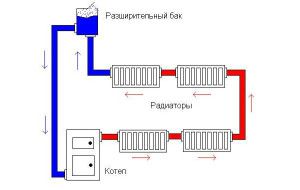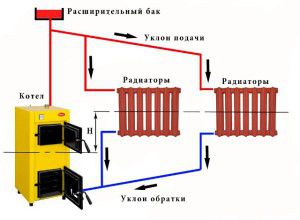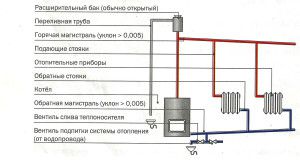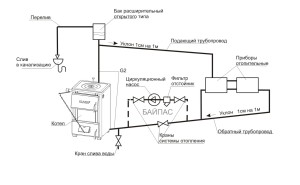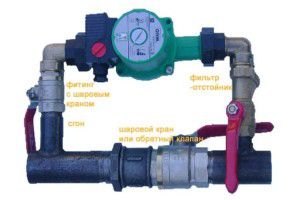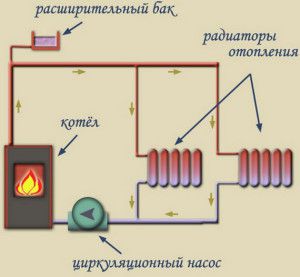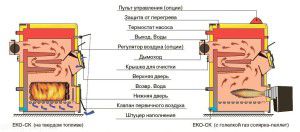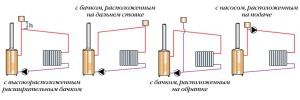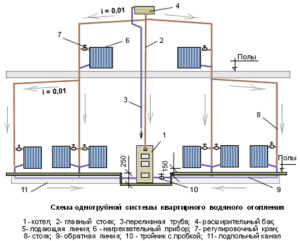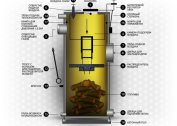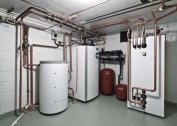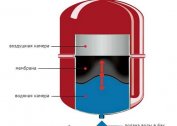Independent design, selection of components and installation of the heating system is one of the most difficult events. Most often they try to initially reduce the complexity of these steps. For this, an open heating system is preferred. Expansion tanks, circuits, pumps - how to determine the optimal parameters for these heat supply components?
Features of open heating
The classic open-type heating system for a private house differs from the closed one in terms of pressure. It is equal to atmospheric. Therefore, the arrangement of this type of heat supply requires significantly fewer components, accurate calculations. But this does not mean that the scheme of open heating can be made unprofessionally.
For automatic stabilization of the coolant pressure in the pipes, the system has an open expansion tank for open heating. It is the design of this component that distinguishes the open heat supply scheme from the closed one. The movement of the coolant can be carried out in two ways:
- Due to the thermal expansion of hot water. For this, an accelerating riser is required. According to this scheme, an open heating system with natural circulation is designed;
- Installation of pumping equipment. It allows you to increase the speed of movement of the coolant. A pump in an open heating system is necessary if the total length of the mains exceeds 25 m.
In addition, it is necessary to reduce the friction index of water as it passes through the pipes. For this, the diameter of the latter should be at least 30 mm. Otherwise, the hydraulic resistance will increase, which will reduce the natural circulation.
The determining component in the circuit is a boiler for an open heating system. It is important not only to choose the right design and operating principle of the device, but also to comply with all installation rules.
Despite the fact that the cost of an open heating system with a pump will be significantly lower than that of a similar closed system, the installation of the first is difficult. This must be taken into account when designing a heat supply.
Choosing an Open Heat Supply Scheme
At the first design stage, it is important to choose the right scheme for an open heating system with a pump. It depends on the parameters of the house, the required thermal regime of the heat supply and financial capabilities.
Consider the main parameters that will directly affect the selection and further calculation of an open heating system:
- Total area of heated premises. If this characteristic is less than 60 m² - you can install a gravity system;
- Storeys and ceiling height. For the gravitational system, a prerequisite is the presence of accelerating runoff. Without it, air may appear in an open heating system and circulation will deteriorate;
- Estimated thermal operation. For low temperature, an open heating system with a circulation pump is used. Otherwise, a slight expansion of the water will not create the necessary circulation.
Only after a thorough analysis of these indicators, as well as calculation of heat losses in the house, can you decide whether to put open heating with or without a pump.
It is best to calculate the heat loss of a building using specialized programs.Their demos are free.
Gravity heating system
The main difference between gravitational and the rest is the complete absence of any mechanisms for the forced movement of fluid through pipes. Those. this process is carried out only due to the thermal expansion of hot water.
For the correct operation of the heat supply, an accelerating riser is mandatory. It is mounted directly after the boiler and is located vertically. Its height should be at least 3.5 m. If this condition is not fulfilled, then the heated liquid coming from the boiler for an open heating system will not have sufficient speed.
In addition to this factor, it is necessary to take into account the specifics of organizing an open heating system with natural circulation:
- Mandatory pipe slope. The supply pipe from the riser must be tilted towards the radiators. The reverse is to the boiler. Tilt level - 1 cm per meter;
- The boiler is located at the lowest point in the circuit;
- For normal operation open expansion tanks for heating systems are needed. They are also mounted for forced circulation circuits.
Installing an electric boiler for an open gravity-type heating system is not recommended. Just like the gas counterpart. This is due to the high likelihood of air jams that can lead to overheating of the heat exchanger.
To increase the efficiency of work in an open heating circuit with natural circulation, the diameter of the riser pipe should be 1 size smaller than the cross section of the main line.
Forced circulation in heating
Recently, owners of private houses and cottages have been modernizing the heating system, installing only one component - a pump. It is designed to improve coolant circulation.
In general, the arrangement of an open heating system with a circulation pump is no different from the above. It is important to choose the right location for the pump. It is mounted on the return pipe before it enters the heating boiler. The optimum distance should be 1.5 m.
For this open heating circuit, the following points must be considered:
- The pump is installed on the bypass. This is necessary to ensure the circulation of water in case of breakage or blackout;
- Be sure to install a check valve. It will prevent the reverse circulation effect;
- During installation, the direction of movement of the coolant is taken into account.
The advantage of using an open heating circuit with a pump is to reduce the inertia of the system. Due to increased circulation, batteries and radiators will heat up faster.
For an open heating circuit with a circulation pump, its parameters should be calculated - pressure and capacity.
Complete open heating system
In addition to the pump in an open heating system, other components should be selected. The efficiency and effectiveness of the entire heat supply scheme will depend on the correct choice.
For the correct calculation of an open heating system, first of all, its rated power is calculated. If the thermal insulation of the building is good, you can take the ratio that 1 kW of thermal energy is required per 10 m² of area. For a more accurate calculation, it is recommended to use special programs. With their help, you can draw up a correct scheme of open heat supply, calculate the optimal characteristics of its components.
For a minimum configuration of the heating system, you will need such elements:
- Boiler;
- Expansion tank;
- Pipelines;
- Radiators and batteries.
The requirements for the last two are low.Most often, polymer pipes are used to equip the heat supply. But experts recommend using a steel pipe for the riser. This is due to the high temperature in this part of the open heating system for a private house.
Almost all models of polymer pipes are designed for temperature exposure not higher than + 90 °. This should be considered when completing the system.
Choosing a boiler for outdoor heating
First of all, it is necessary to warn that the installation of gas and electric boilers for an open heating system is prohibited. Often air congestion forms in the system, which will negatively affect the operation of the equipment and can lead to emergency situations. Therefore, the only alternative are solid fuel models or diesel-fired boilers.
The boiler must be installed in accordance with all requirements. It is located in a separate room where you can not store fuel. The boiler room must have forced air circulation. To optimize the operation of the equipment, the installation of a sandwich chimney is recommended.
In addition to these factors, there are specific requirements for the normal adaptation of an open heating system boiler:
- Do not install boilers for long burning. They are designed for low temperature system operation. In this case, the expansion of the coolant will not be enough for circulation;
- If the pump group is not installed in the system, a separate check valve installation is required;
- The boiler in the open heating system for a private house should be located at the lowest point in the circuit.
If the equipment does not include a temperature sensor, it should be installed separately. For accuracy, it is mounted on the supply pipe immediately after the boiler.
To remove air in an open heating system, installing an air vent will not help solve the problem. It only works if the pressure in the system exceeds atmospheric.
Models of expansion tanks for an open system
To compensate for the thermal expansion of the coolant and timely control of its level, it is necessary to install an expansion tank for open heating. It is located at the highest point in the system and can perform several functions at once.
First, the optimal volume of an open expansion tank is calculated for heating systems. It should be at least 5% of the amount of coolant in the system. The standard design has 3 nozzles that perform the following functions:
- Inlet pipe. With its help, an expansion tank is connected to an open heating system. Typically, its diameter is 1 size smaller than that of the riser to which the installation is being performed. Therefore an adapter is needed;
- Circulation pipe. Through it, hot water flows further along the highway;
- Signal pipe. It is necessary to notify of a critical decrease in coolant level. When opening the tap, water does not flow from it - the system should be supplemented.
Additionally, an expansion tank for open heating can be upgraded. In some cases, it can act as a make-up unit. For this, an additional pipe is required, which is connected to the water supply. With a critical decrease in the volume of hot water, you can quickly supplement the system by opening the shutoff valves.
There are several schemes for installing an expansion tank. For heat supply of an open type with a pump, it can be mounted on a distant riser. This option is rarely used, since the effectiveness of such a scheme is extremely low. Most often, the expansion tank is installed in the near riser for timely monitoring of the state of heating.
It is forbidden to use polymeric materials for the manufacture of an expansion tank. Steel is best suited for this.
DIY outdoor heating installation
After the correct calculation of the open heating system and the selection of all components, you can proceed to installation. It is preliminary recommended to draw up an arrangement of all elements with their technical characteristics.
First, we determine the pipe wiring diagram. It can be of the following types:
- Single tube. In it, devices are connected to the system in series. Advantages - easy installation, minimum consumables. Disadvantages - quick cooling of the coolant;
- Double pipe. To drain the cooled water, a return line is mounted. In this way, the heat distribution throughout the system can be optimized.
In any case, it is necessary to install an open expansion tank for heating systems. For branching pipelines, tees are installed. Collector circuits for an open heating system with a pump are not applicable.
Work is best done in the summer. Installation of pipelines requires special attention, since it is imperative to observe the angle of inclination. If this parameter is insufficient, a significant deterioration in the circulation of hot water is possible.
In the video material you can familiarize yourself with the specifics of the heating operation during natural and forced circulation:
